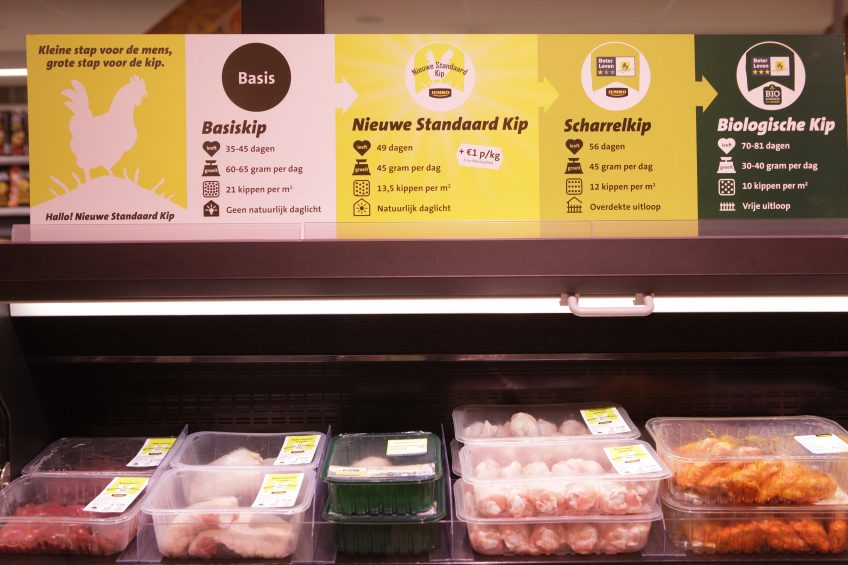Chicken of Tomorrow is here today

Over the last three years, the variety of chicken that is for sale in supermarkets has changed in a major way. By the end of this year a Dutch supermarket which sells regularly produced chicken meat will be hard to find.
“A different kind of chicken will enter the Dutch supermarkets,” supermarket organisation the central bureau of foodstuffs (CBL) proudly announced in early 2013. Months of meetings between representatives of producers, slaughterhouses, large supermarkets and the former product board preceded the announcement. The switch to the so called Chicken of Tomorrow on the supermarket’s shelves would have to be realised in phases by the year 2020 at the latest. It involved demands concerning animal welfare, such as the use of slower growing breed, more space in the house, natural day/night rhythm and distraction materials, public health (less antibiotics), and environment (responsible soy in feed, emissions of ammonia and particulates, and closed mineral cycles).
Four years have gone by and a lot has changed. Almost every supermarket abandoned the sale of regularly grown broiler meat, or will stop selling it during the course of 2017. Over the last three years supermarkets have massively switched to new chicken concepts, which are now the bottom end of the market. They use names such as Good Nest Chicken, New Standard Chicken, Slow Growing Chicken, Chicken with Plume Guarantee, Gildehoen, Aunt Door and Comfort chicken. In addition the extensive indoor (Better Life 1 star) and organic chicken (Better Life 3 stars) are on offer in the higher segment.
In early 2015 the Dutch anti-trust authorities decided the agreements between supermarkets and industry concerning the Chicken of Tomorrow were in conflict with the ban on cartels, because the consumer is willing to pay for sustainability, but not for the (limited) improvements, especially concerning animal welfare, the Chicken of Tomorrow delivered. Animal rights action group Wakker Dier was pleased with the anti-cartel ruling, which killed the concept Chicken of Tomorrow. Since the introduction Wakker Dier called the Chicken of Tomorrow a bad plan to replace the regular ‘bloated’ or ‘exploding’ chicken. According to Wakker Dier, animal welfare improvements were inadequate, but in early 2016 supermarkets that had made the switch received a compliment from Wakker Dier.
Own manner
Despite the anti-trust authorities’ negative advice, almost every supermarket gave shape to a new basic chicken in the shops. These new basic chickens in all cases fit within the original Chicken of Tomorrow concept. In May 2014 the biggest Dutch supermarket chain Albert Heijn surprised everyone with the introduction of the New AH Chicken, which made it the first supermarket to do so. Other supermarkets followed this example, often with (slightly) higher demands on production. The original Chicken of Tomorrow concept has a maximum average daily gain of 50 grammes, a maximum occupancy of 38 kg per m2 and the use of bales of straw as distraction material.
In October 2014 supermarket Jumbo initiated the New Standard Chicken in order to exceed the basic standards of the Chicken of Tomorrow. The New Standard Chicken has a daily gain of about 45 grammes. With regular broilers this is 60-65 grammes. The maximum occupancy is 30 kg per m2. This is 42 kg per m2 for regular broilers. The New Standard Chicken also requires daylight in the house and sprinkling grain.
Last year the share of chicken meat of concept chickens in supermarkets grew quickly. Since early 2016 no chicken of regular broilers can be found in the shops of the two largest supermarket chains. Wakker Dier calls it a breakthrough.

“Almost half of the Dutch chicken consumption became ‘bloated chicken free’ overnight,” the welfare organisation said. Bloated chicken – meaning regular fast growing broilers. Other supermarkets are making their presence known. One after the other announced the entry of a new basic chicken. At the end of 2017 there won’t be many supermarkets in the Netherlands where the consumer can choose between chicken meat of regular broilers or chicken meat from a concept which focuses more on animal welfare. Broiler farmer and board member of farmers’ organisation LTO/NOP, Jan Verhoijsen, regrets that consumers are deprived of the choice for chicken of regular broilers.
Better meat and less antibiotics
Besides animal welfare, meat quality is an incentive for retailers to switch from regular meat to concept chickens more rapidly. Problems with meat quality that occur in meat of regular broilers, are almost non-existent in slower growing concept chickens. This mainly counts for ‘wooden breast’, ‘white striping’ and so called ‘spaghetti meat’ in which muscle fibers fall apart. More support for the new concepts is the use of antibiotics. Increasing concerns about the health risks caused by resistance development as a result of careless use of antibiotics both in people and animals, increases the demand for livestock products that were produced without the use of antibiotics. Broiler farmers with slower growing chicks and a lower occupancy use little or no antibiotics.
‘Bloated chicken’ disappeared from fresh food aisle
Welfare organisation Wakker Dier is enthusiastic about the rapid withdrawal of regular chicken from the supermarket shelf. “We are pleased bloated chicken has largely disappeared from the fresh food aisle. Now the processed meats division has to follow. Jumbo and Albert Heijn already took a leading role in this,” says Anne Hilhorst, Wakker Dier spokesperson. “Unfortunately there are a few smaller chains such as Emté and Jan Linders that do sell bloated chicken. This year we will pay attention to this.” Wakker Dier says a lot more has to change. Hilhorst adds: “It is an intermediate step. Despite the decrease of the worst wrongdoings, lameness and sole lesions do also occur among new basic chickens.”
“It went very fast”
The quick switch in supermarkets from regularly produced chicken to a new basic chicken had major implications for all other links in the production chain. “It went very fast,” says Paul van Boekholt, managing director Northern Europe and Southern Africa at breeding organisation Hubbard. Hubbard supplies by far the greatest part of all genetic materials for the new chicken concepts. Meanwhile, also other big breeding companies such as Ross and Cobb have marketed slower growing chickens as a test for new concepts.
The estimated number of slaughtered concept chickens is about 2.7 million birds per week now. “This fills in 90% of the chicken sales in Dutch supermarkets. In terms of fresh meat, Dutch supermarkets require approximately 3 million broilers per week. This means the increase in the number of concept chickens in the Netherlands will level off after two years of linear growth. The current production can fill in the market needs,” he adds. Van Boekholt estimates that approximately 20% of the 2.7 million non-regular chicks have lived according to the standards of the higher ‘one Better Life star’. The other 80% is one of the concepts used by supermarkets for their new basic chicken.
Wakker Dier thinks all chicken meat in supermarkets ought to have at least one Better Life star in 2020. According to spokesperson Hilhorst this is achievable. “In particular the fact that supermarket chains have their carcass balance on a sounder footing due to the new concepts, allows them to move on. We do regret reading that some farmers are unable to make the switch to Better Life seal due to restrictions in the building block. We hope this kind of restrictions will be solved soon.”
Also Van Boekholt expects the share of chicken with a Better Life seal to grow in the coming years. “With the introduction of Kip van Morgen (Chicken of Tomorrow) people said they expected it to be at the expense of the market for chicken with one star of the Dierenbescherming. The opposite turned out to be true. The new basic chicken in the supermarket has narrowed the difference between the regular chicken and the chicken with a Better Life star. For consumers who want to do something extra it will be easier to choose chicken with a star.” Approximately one third of the more than 500 broiler farmers in the Netherlands is keeping concept chickens. Two third keeps their focus on the production of regular broilers, especially for export.
Following the market
Now, supply and demand for the new basic chicken for the Dutch supermarkets appear to match. According to Van Boekholt broiler farmers and slaughterhouses have an interest in not scaling up to more concept chickens too soon. “It is better to follow the market. The cost price of concept chickens is higher than the cost price of regular broilers. Producing animals that cannot be sold at a cost covering price is not interesting. Create some scarcity in the market instead. It is specifically up to slaughterhouses to fill in this role.” Among broiler farmers there appears to be more than enough interest in participating in concepts for the domestic market. Van Boekholt: “The first years broiler farmers and also breeders were sceptical of the new poultry keeping systems, but this attitude has changed. They see colleagues who participate in a new chicken concept make a living with less stress. Of course you have to believe in it and the different approach must suit you. If this is not the case, a poultry farmer or breeder should not start with it.”
Rest of the world
The Netherlands is unique in the world with a rapid turnaround from meat of regular broilers to concept chicken on the supermarket shelves. “Other countries show developments in this direction, but it will not go as fast in any country as it went in the Netherlands,” Van Boekholt expects. “The disappearance of regular chicken from the supermarket is a joint accomplishment of retail and slaughterhouses. Under pressure of NGO’s such as Wakker Dier, among other things. This combination of factors can’t be found in any other country.” Van Boekholt has observed a gradual increase in sales of chicken that was produced according to higher sustainability standards. “In England for instance, the demand for chicken meat of birds with a better life started 15 years ago. The sales of this chicken has grown to a market share of about 10%. That percentage is stable at the moment. This is also the case in France, where about 40% of the market consists of slower growing chicken. In other countries a great deal of attention is paid to new chicken concepts. This is only the case in well developed countries where welfare has reached a certain level.”









